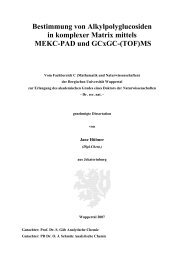The Influence of Oxidative Stress, Carcinogens and Cloning on DNA ...
The Influence of Oxidative Stress, Carcinogens and Cloning on DNA ...
The Influence of Oxidative Stress, Carcinogens and Cloning on DNA ...
Create successful ePaper yourself
Turn your PDF publications into a flip-book with our unique Google optimized e-Paper software.
13<br />
Introducti<strong>on</strong><br />
in normal embryos during early development (131, 132) . However, different studies showed an<br />
evidence that incomplete or inappropriate epigenetic reprogramming <str<strong>on</strong>g>of</str<strong>on</strong>g> d<strong>on</strong>or cell nuclei is<br />
the main cause behind the low cl<strong>on</strong>ing efficiency, high embry<strong>on</strong>ic <str<strong>on</strong>g>and</str<strong>on</strong>g> foetal losses after<br />
SCNT <str<strong>on</strong>g>and</str<strong>on</strong>g> developmental abnormalities (133, 134) . At different stages, inappropriate repro-<br />
gramming occurs leading to failure <str<strong>on</strong>g>of</str<strong>on</strong>g> cl<strong>on</strong>ing.<br />
Simply talking, other logical reas<strong>on</strong>s rather than the failure <str<strong>on</strong>g>of</str<strong>on</strong>g> epigenetic reprogramming can<br />
explain the unsuccessful cl<strong>on</strong>ing procedure in the embry<strong>on</strong>ic stage. <str<strong>on</strong>g>The</str<strong>on</strong>g>se reas<strong>on</strong>s could be<br />
the incompatibility between the enucleated egg <str<strong>on</strong>g>and</str<strong>on</strong>g> the transferred nucleus, or an egg with a<br />
newly transferred nucleus may fail to divide or develop properly, or simply the implantati<strong>on</strong><br />
<str<strong>on</strong>g>of</str<strong>on</strong>g> the embryo into the surrogate mother might be impossible. On the other side, the surviving<br />
cl<strong>on</strong>es can exhibit c<strong>on</strong>genital defects (135) such as LOS (126) , kidney or brain malformati<strong>on</strong>s <str<strong>on</strong>g>and</str<strong>on</strong>g><br />
impaired immune systems.<br />
1.2.7.2 Effect <str<strong>on</strong>g>of</str<strong>on</strong>g> cl<strong>on</strong>ing <strong>on</strong> epigenetics<br />
High rates <str<strong>on</strong>g>of</str<strong>on</strong>g> embry<strong>on</strong>ic <str<strong>on</strong>g>and</str<strong>on</strong>g> foetal mortality (127, 136) , <str<strong>on</strong>g>and</str<strong>on</strong>g> an increased incidence <str<strong>on</strong>g>of</str<strong>on</strong>g> c<strong>on</strong>genital<br />
defects (135, 136) have been associated with perturbati<strong>on</strong>s in developmentally important epigenetic<br />
marks (127) such as <strong>DNA</strong> methylati<strong>on</strong> <str<strong>on</strong>g>and</str<strong>on</strong>g> hist<strong>on</strong>e modificati<strong>on</strong>s (137-139) .<br />
<str<strong>on</strong>g>The</str<strong>on</strong>g> methylati<strong>on</strong> <str<strong>on</strong>g>of</str<strong>on</strong>g> <strong>DNA</strong> is involved in l<strong>on</strong>g-term epigenetic silencing <str<strong>on</strong>g>of</str<strong>on</strong>g> specific sequences<br />
(43) , including transpos<strong>on</strong>s * , imprinted genes <str<strong>on</strong>g>and</str<strong>on</strong>g> pluripotency-associated genes in the cl<strong>on</strong>ing<br />
process (140) .<br />
Various studies had dem<strong>on</strong>strated that SCNT procedure can impact <strong>on</strong> the global <strong>DNA</strong> methylati<strong>on</strong><br />
status <str<strong>on</strong>g>of</str<strong>on</strong>g> cl<strong>on</strong>ed bovine embryos by insufficient active de-methylati<strong>on</strong> <str<strong>on</strong>g>of</str<strong>on</strong>g> the nuclear<br />
d<strong>on</strong>or <strong>DNA</strong> after transplantati<strong>on</strong>, by delayed or attenuated further passive de-methylati<strong>on</strong>, <str<strong>on</strong>g>and</str<strong>on</strong>g><br />
by precocious de novo methylati<strong>on</strong> before the 16-cell stage (134, 137, 141, 142) .<br />
Other studies had revealed aberrati<strong>on</strong>s in global <strong>DNA</strong> methylati<strong>on</strong> status <str<strong>on</strong>g>of</str<strong>on</strong>g> cl<strong>on</strong>ed embryos<br />
<str<strong>on</strong>g>and</str<strong>on</strong>g> fetuses in different species (137, 143-145) . In general, an increase in <strong>DNA</strong> methylati<strong>on</strong> level<br />
in cattle cl<strong>on</strong>es has been correlated with poor developmental potential <str<strong>on</strong>g>of</str<strong>on</strong>g> cl<strong>on</strong>ed pre-<br />
implantati<strong>on</strong> embryos (137) <str<strong>on</strong>g>and</str<strong>on</strong>g> with compromised foetal overgrowth (144) . <str<strong>on</strong>g>The</str<strong>on</strong>g> global changes<br />
in methylati<strong>on</strong> states have also been described for specific genes <str<strong>on</strong>g>and</str<strong>on</strong>g> n<strong>on</strong>-coding <strong>DNA</strong> se-<br />
quences under epigenetic c<strong>on</strong>trol (127, 133, 138, 139, 142, 146) . Although the overview <str<strong>on</strong>g>of</str<strong>on</strong>g> these reports<br />
shows a relati<strong>on</strong> between the aberrant methylati<strong>on</strong> level <str<strong>on</strong>g>and</str<strong>on</strong>g> the poor success for the cl<strong>on</strong>ing<br />
process, the genomic methylati<strong>on</strong> status <str<strong>on</strong>g>of</str<strong>on</strong>g> live <str<strong>on</strong>g>of</str<strong>on</strong>g>fspring was not studied so far.




